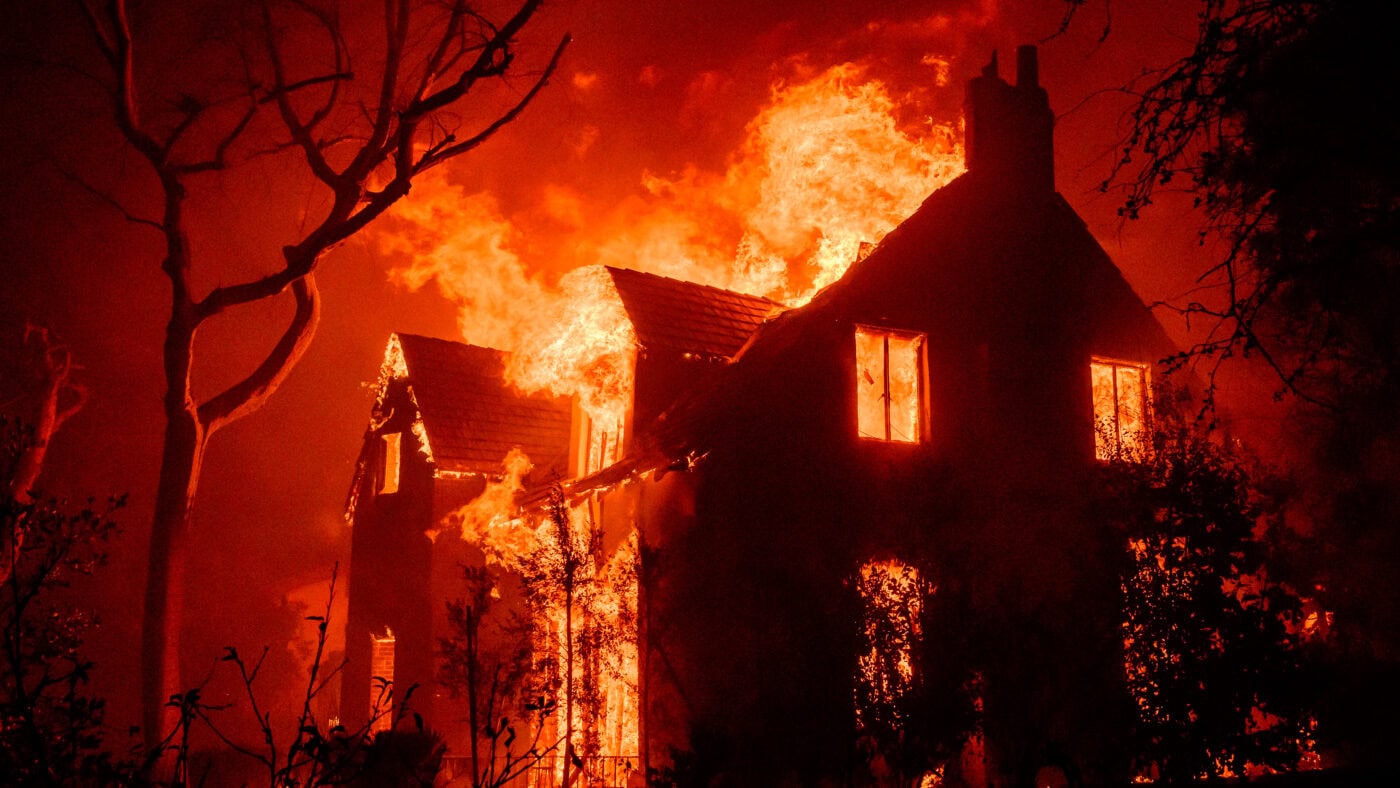As Los Angeles burns, with ten dead and over 10,000 homes destroyed, a deeper story emerges about how well-intentioned red tape has turned a natural disaster into a regulatory catastrophe. The fires raging through Pacific Palisades and beyond aren’t just revealing the physical vulnerability of California’s hillside communities – they’re exposing the fundamental weakness of attempting to substitute market mechanisms for political control in managing risk.
The roots of this crisis stretch back to 1988, when Californian voters approved Prop 103 – a superficially appealing ballot measure requiring insurers to seek approval through public hearings for any rate increases. It seemed like classic consumer protection: why not make insurance companies justify their prices? But as Friedrich Hayek taught us, prices aren’t just numbers – they’re information signals that coordinate complex human behaviour. When you prevent prices from adjusting to reality, you don’t just change the cost of something; you distort the entire system of incentives and information that helps society manage risk.
This is exactly what has happened in California. Insurance companies weren’t simply prevented from raising prices – they were blocked from using modern catastrophic risk modelling to assess future dangers. In a world of changing climate risks, insurers were forced to navigate by looking in the rear-view mirror, using historical data that became increasingly irrelevant with each passing year.
The predictable result? Seven of California’s twelve largest insurers simply stopped writing new policies. You can’t force private companies to lose money indefinitely, and if they can’t charge prices that reflect real risks, they’ll exit the market entirely. This isn’t greed – it’s basic economic survival.
Nature abhors a vacuum, and so does politics. As private insurers fled, California expanded its ‘insurer of last resort’, the FAIR Plan. The numbers here are staggering: $458 billion in exposure backed by just $385 million in unreserved funds and $2.5 billion in reinsurance. This isn’t insurance so much as magical thinking, pretending that political mandates can somehow substitute for actual financial capacity.
The consequences are now becoming brutally apparent. The San Francisco Chronicle reports that just the FAIR Plan’s exposure in the Los Angeles fire zone ZIP codes could reach $24 billion – nearly ten times its total resources. This isn’t just a gap; it’s an abyss. And it’s one that every Californian will ultimately have to help fill.
Consumer Watchdog – ironically, the very organisation that championed the 1988 regulations – now estimates that covering FAIR Plan losses could require surcharges of $1,000 to $3,700 on every insurance policy in California. The attempt to protect consumers from higher insurance prices will end up forcing them to pay far more than they would have under a market system. Kim-Mai Cutler has a fantastic thread on how their law has created a system that profits them, while incurring losses for the rest of America.
But the distortions run deeper than just insurance prices. By suppressing price signals about risk, California’s regulatory regime encouraged development in fire-prone areas while simultaneously reducing incentives for fire prevention. When you can get subsidised insurance regardless of risk, why spend extra money on fire-resistant materials or clearing brush? When property owners don’t bear the full cost of their location decisions, they’ll naturally take more risks than they would in a free market.
The coming reconstruction will reveal another layer of regulatory failure. The inability to price risk properly means that many homeowners will discover their FAIR Plan coverage is inadequate for rebuilding. Banks may become reluctant to lend in areas where insurance is difficult to obtain. Property values will likely decline, reducing the tax base precisely when public resources are most needed. This is how regulatory failures compound: each intervention creates new problems that seem to require yet more intervention.
There’s a profound lesson here about the limits of political control over economic reality. California’s insurance commissioner position has become what political observers call a ‘graveyard’ – because it’s impossible to reconcile the political demand for low insurance rates with the economic reality of increasing fire risk. This is what happens when you try to regulate away basic economic facts: reality always wins eventually, but the cost of delay makes the final reckoning far worse than it needed to be. One suspects, mind, that the next election for this role might well be hot.
The solution isn’t complicated, but it requires political courage: California must restore market mechanisms that can properly price and manage risk. That is not going to be easy in the wake of a fire that’s wiped out homes and lives, but it is the right thing to do. It will mean allowing insurers to use modern risk assessment tools, permitting market-based pricing, and developing targeted assistance for truly vulnerable populations rather than trying to suppress prices for everyone.
As the ashes settle, the grim alternative is already becoming clear: a system where many Californians will find themselves effectively uninsurable, facing either no coverage at all or costs far higher than they would have paid under a market-based system, including the grim prospect of burned out homes and reliance on the goodwill and kindness of strangers to pick up the pieces of their lives. This is the cruel irony of interventionist policies: in trying to protect consumers from market prices, they ultimately expose them to far greater risks and costs.
As Los Angeles begins its recovery, the state faces a choice: continue down the path of market suppression and watch its insurance system collapse entirely, or embrace reforms that allow markets to price risk properly. The fires have made the cost of choosing wrongly devastatingly clear.
This is more than just a California story – it’s a warning about the dangers of allowing political imperatives to override market mechanisms. When we prevent prices from telling the truth about risk and scarcity, we don’t eliminate the underlying reality. We just ensure that when it finally breaks through, the consequences will be far worse than they needed to be.
The insurance crisis, however, is merely the most visible manifestation of a deeper regulatory sclerosis that has left one of the world’s richest regions surprisingly vulnerable to entirely predictable threats. California’s GDP would make it the world’s fifth-largest economy if it were an independent nation, it hosts the world’s leading technology companies, and it sits beside the largest ocean on Earth. Yet it cannot reliably deliver water pressure to fire hydrants or deploy modern technology to fight fires. How did we reach this absurd situation?
Consider water infrastructure. California hasn’t built a major new reservoir since 1992, despite adding 10 million residents. Environmental regulations, particularly those protecting populations of Delta smelt, have actively reduced water availability to Southern California. The state has prioritised conservation over capacity expansion, effectively forcing a zero-sum game where every new resident reduces the water security of existing ones. Meanwhile, desalination projects face years of environmental reviews and regulatory challenges – the Carlsbad plant took 14 years to approve and build, despite using proven technology (and that’s a liberal interpretation, the scheme from conception of the idea took 24 years to complete).
This infrastructure paralysis would be somewhat understandable if California lacked resources. But this is a state that hosts companies at the bleeding edge of artificial intelligence, robotics, and autonomous systems. Yet while Silicon Valley develops self-driving cars and robots that can perform surgery, firefighters still depend primarily on human-piloted helicopters and planes to deliver water to wildfires – just as they did fifty years ago. Where are the autonomous drone swarms that could provide continuous, precision water delivery? Why aren’t we using AI-powered systems to optimise fire response and predict fire spread in real-time?
The answer lies in what economic historian Joel Mokyr calls ‘the burden of knowledge’ – except in California’s case, it’s not the burden of acquiring new knowledge that’s holding them back, but the burden of regulatory frameworks that make deploying new knowledge nearly impossible. The same regulatory mindset that has paralysed the insurance market has also frozen innovation in public safety and infrastructure.
Consider what it would take to deploy a network of autonomous firefighting drones in Los Angeles County. You’d likely need approvals from the FAA, state and local authorities, environmental impact assessments, almost certainly public hearings about noise and privacy concerns, studies about wildlife impact, and countless other regulatory hurdles. That’s before they need their own fleet insurance, licences, and have to raise finance to fund the initiative. Each agency would have effective veto power, and none would have a strong incentive to say yes. Meanwhile, the fires don’t wait for bureaucratic processes to conclude. Ideas people would start a project and move on. Solutions lost, like tears in rain.
This points to a crucial insight about the relationship between regulation and innovation: the cost of insurance is not independent of our ability to prevent and fight fires effectively. If autonomous systems could respond to fires faster and more effectively than human teams, if smart infrastructure could maintain water pressure precisely where it’s needed, if AI could optimise evacuation routes in real-time – then insurance premiums could remain affordable even as climate risks increase. But achieving this requires allowing innovation in public safety to move at the speed of technology, not bureaucracy.
Instead, California has created a regulatory environment that simultaneously prevents insurance companies from charging market rates and prevents the deployment of technologies that could reduce the risks that drive those rates. This double bind ensures that the system becomes more fragile over time, as risks increase while our ability to manage them remains frozen in amber.
The tragic irony is that California’s regulatory regime, ostensibly designed to protect the public interest, has actually prevented the development of more effective public protections. The same state that pioneers autonomous vehicles on its roads somehow can’t approve autonomous systems to fight fires. The same region that leads the world in AI development still fights fires primarily with tools and techniques that would be familiar to firefighters from fifty years ago.
This points to a broader truth about regulation and innovation: it’s not enough to simply generate new technologies – you need a regulatory environment that allows those technologies to be deployed in ways that solve real problems. California has created a system that excels at the former while actively preventing the latter.
The path forward requires not just reforming insurance regulations, but fundamentally rethinking how we regulate innovation in public safety and infrastructure. Frameworks must exist that can evaluate and approve new technologies quickly while still ensuring safety – something closer to how we regulate software than how we regulate bridges. Every new approach needs to stop being seen as a threat to be contained and innovation must be viewed as essential to public safety.
Because ultimately, the choice isn’t between regulation and chaos – it’s between regulations that foster innovation and those that prevent it. California’s current crisis demonstrates the cost of choosing wrongly. A truly progressive approach to public safety would harness the state’s extraordinary technological capabilities to protect its citizens, rather than allowing regulatory sclerosis to keep those capabilities locked in research labs and people’s imaginations while Los Angeles burns.
Click here to subscribe to our daily briefing – the best pieces from CapX and across the web.
CapX depends on the generosity of its readers. If you value what we do, please consider making a donation.


